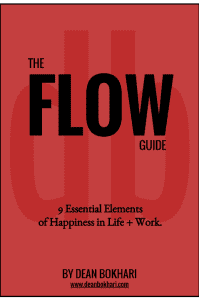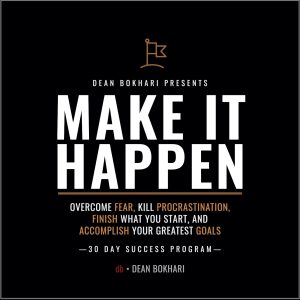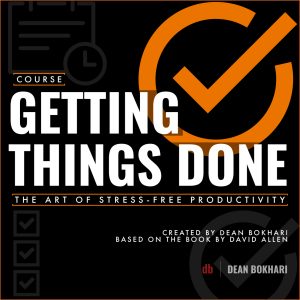Between mid-March and mid-May 2020, the percentage of U.S. employees working from home more than doubled, from 31% to 65%. That’s over 100 million more people working from home. And guess what? People prefer it. According to a recent survey from Gallup, “more than half of at-home workers say they would prefer to continue working remotely as much as possible once restrictions on businesses and school closures are lifted.” And according to the same survey, the majority of leaders and managers say they’ll let their employees work remotely more often as a result of this experience. Bottom line? Remote work is going to become the next normal—even as we move past the pandemic.
Since working from home is here to stay, it would be helpful to have a guide to help you stay focused and productive… Which is why I put this bad-boy together for you. It’s filled with tips and strategies for boosting work-from-home motivation and productivity.
If you’re an employee or an entrepreneur, you can use these tips to boost your own focus and productivity. If you’re a leader or manager of teams, you can use this guide for both yourself and your team.
Let’s dive in.
Table of Contents
This guide is split into 3 parts. Use the clickable table below to jump around to different parts of the article, or hit the Play buttons to listen to the audio versions.
PART I.
WORKING FROM HOME—TIPS TO STAY PRODUCTIVE
PART II.
STAYING INSPIRED + CREATING SYSTEMS WHILE WORKING FROM HOME
PART III.
HOW TO AVOID DISTRACTIONS WHILE WORKING FROM HOME
Part I. Working From Home—Tips to Stay Productive
Working from home is not like going to an office or some other outside location to get your work done… There are all sorts of productivity pitfalls to watch out for. In this first section, we’ll get into the nuts and bolts of remote-productivity: structuring your work-space, scheduling, prioritizing, list-making and more.
1.
Maintain a designated workspace.
Your environment will either trigger or hinder your productivity… Which is why it’s crucial to have a designated workspace for working from home.
Find a separate room, a corner, a nook, or even a wall——anywhere in your house——and claim it as your designated workspace.
Clear the clutter, stock your desk, and make it your space to work. Doing this helps communicate to your brain that this is the spot for you to focus on working without distraction. It tells your brain you’re in the place where you get things done—where you do work productively.
2.
Don’t be a slob—take a shower, get dressed.
Just because you’re working from home doesn’t mean you should go to your desk in a bathrobe. Take a shower. Get dressed. This is about how it makes you feel. When you look like a pro, it’ll help you feel like a pro. It’s about creating the proper mental triggers to get you into work-mode and to keep you productive while working from home.
When you dress sharp, you feel sharp. Now, “sharp” is subjective—it depends on your own personal style.
The most important thing is not that you put a suit on, it’s that you put something on that’s comfortable and makes you feel good when you look in the mirror. In my view, it’s about self-dignity.
3.
Go out for a walk.
Not on a treadmill. Not in your house. Literally go outside for a walk. This ensures you get some sun on a daily basis, which provides you with Vitamin D, which has numerous benefits—including elevated mood and a heightened sense of wellbeing. It also boosts your immune system. Studies have also proven that walking outside can boost your creativity—I can attest to that one first hand. It’s the reason I take a small notebook with me on my walks.
Bottom line: If you feel good, you’ll be more productive. I like to start my day with a morning walk. It sets the tone and gives me time to think about my outcomes for the day.
Next time you need a break, step outside for a bit. Go for a quick walk or do some stretching under the sun. You’ll feel invigorated and focused when you get back to your desk.
4.
Don’t just manage your time—manage your energy too.
When you work on the most important thing on your agenda when you have the least amount of energy, your results will suffer. But it’s what most people do. They piss away their most productive hours by scrolling social media, ordering shit on Amazon, and checking email. Stop that.
Identify your Peak Performance Period (PPP)—which is a 3—5 hour window when you have the highest amount of energy, willpower, motivation and mental clarity. This is the time of day when you should be working on your most important stuff. My PPP is in the morning, between 7:00AM — 12PM.
Yours will differ, but it’s important to figure it out because it’ll have a major impact on your success regardless of what you do.
Quick side tip: Most people are most productive two hours after waking up.
Further reading + listening:
Find Your Peak Performance Period »
5.
Exercise.
Speaking of managing your energy—there’s no better way to boost it than exercise. If you’re an adult, exercise is not optional. It’s a must. It’ll reduce your stress, increase your energy, and give you a sense of wellbeing. Not to mention, you’ll live longer.
Exercise at least five days a week.
Get those #RonaGains.
Further reading + listening:
How to wake up early and establish a morning workout routine at home »
6.
Maintain motivation with a master list.
If you keep your list in your head, you’re dead. Start a master list to hold all your goals, projects, and ideas. Keeping a list like this is like having a second brain. And it can skyrocket your productivity.
As you’re writing out your list, think about your bigger, long-term goals (such as a project you’re working on) as well as your short-term, smaller goals (like executing tasks that will bring your project closer to completion).
Create and maintain a master list of your current goals, projects, and tasks. Doing this will put your mind at ease and keep you organized.
Not doing it will leave you feeling distracted, demotivated, and constantly feeling like there’s more to do. You won’t feel at ease, because you’re trying to carry too many open loops in your head.
Make a “master list” of all your goals and projects.
7.
Each day, write down 1–3 of your most important tasks.
Refer to your master list to make your daily list. Then, get to work, starting with your highest priority task (which is often the one you least want to do). Keep your list with you and in plain view, checking your tasks off as you complete them. This will motivate you and give you a sense of control and accomplishment over your day.
If you want to add some structure to your list, use my 1–2–5 list-making method to prioritize your daily list in the following way: One Big Thing (OBT), 2 Medium Things (2MT) and 5 Little Things (5LT).
Having a list is like having a second brain. And the structure that comes from knowing what needs to get done and how important each of those things is will provide you with focus.
At a minimum, decide on one big thing you must accomplish today no matter what. Start your day with this and don’t let go until you’re done. Yes—of course, you have more than one thing to do. You can get to everything else after you’ve crushed your one big thing for the day.
You can find out your one big thing for any given day by asking yourself the following question:
“What’s the one thing I can do today that would make me call this day a success?”
8.
Make your list actionable + time-bound.
When you’re writing out your list of things to do, make them actionable by adding verbs: instead of writing, “Nora’s birthday gift,” write “Select and order Nora’s birthday gift on Amazon.”
Instead of writing, “Report,” write, “Complete page one of report.”
In addition to that, include how long you expect to spend on the task off to the side in parenthesis or write it into the task itself: “Spend 30 minutes writing page one of report.”
9.
Use time blocking to schedule every minute of every day.
If you don’t control your time, your time will control you.
If you don’t control your time, your time will control you… That’s why time blocking is the single most effective productivity tool in your arsenal.
Time blocking is the productivity practice of plugging everything you need to get done on a given day into a time-slot on your calendar. When you’re working from home, it might be even more important to use time blocking to schedule your day, because you’re the only one holding yourself accountable.
Here’s how it works: You divide your day into blocks of time. Each time block is dedicated to accomplishing a specific task, or a group of related tasks—like those you might find under a big project with lots of action items.
The purpose of time blocking is to keep you focused on working on the specific tasks you’ve blocked away time to work on—and only those tasks.
10.
Set regular working hours.
A writer named Gustave Flaubert once said,
“Be regular and orderly in your life, so that you may be violent and original in your work.”
It’s one of my favorite quotes because it emphasizes the importance of structure and constraints—and how implementing them can skyrocket your productivity and make you more creative than you’ve ever been.
Do yourself a favor: set regular working hours for yourself.
And stick with those hours as much as possible. You want to be able to train yourself to develop the habit of being productive while working from home. Setting regular hours will help you do that.
Also, your family will eventually begin to understand you’re serious about keeping a structured schedule—even while working from home—and they’ll eventually learn to respect your schedule enough not to disturb you during those hours.
If you work with teams of people, let them know what your working hours are, and set “away” notifications on your group collaboration programs if you feel others might benefit from knowing you’re away from your desk at the moment.
Further reading + listening:
Reduce decision fatigue with “No Matter What” commitments »
Part II. Staying Inspired + Creating Systems While Working From Home
While the benefits of working from home are many, not being in the same physical location as your co-workers can hinder your ability to get things done if you have a difficult time with self-discipline or holding yourself accountable. It can also be tough if you thrive around other people. This is why it’s important to stay inspired and connected to your mission. Here are some work from home tips to help you do that.
11.
Remember your WHY to stay inspired.
The best way to maintain work-at-home motivation is to keep your WHY front and center. Your WHY is your purpose—it’s the reason you do the work you do. My WHY is to inspire and empower people everywhere so that they can improve their lives and achieve their goals.
What’s your WHY?
Draft a WHY Statement and keep it in front of you to keep you inspired while you work.
If you lead or manage others, remind them of your organization’s WHY by dropping it in an organization-wide communication channel, like Slack.
Further reading + listening:
How to Find Your WHY and Communicate Your Purpose to the World »
12.
Create start-up rituals + shut-down rituals.
The startup ritual primes your mind to crush the day. The shut-down ritual helps you ease-out of the workday. Examples of startup rituals are things like: going for a walk before starting your work, journaling, envisioning your day, saying affirmations, or engaging in a healthy morning routine at home prior to beginning your work. The goal is to prime your mind to get into work-mode, which is something that can be especially challenging while working from home.
Another challenge for people, is transitioning from “work” to “home” when your work and your home are under the same roof. Having a regular shut-down ritual can help ease you out of work-mode. I like to shut my laptop, shout out “I’m done” and then go change my clothes.
Whichever way you do it, having a start-up + shut-down ritual can help you create a nice mental distinction between “working” at home and “being” at home.
13.
Implement systems to avoid wasting time.
There are two types of systems: 1) habit systems and 2) automated systems.
- Habit systems: These types of systems are rituals or routines that help you attain your long-term goals or maintain ongoing goals. This includes things like working out at the same time each day, spending 10 minutes meditating, taking a quick stretch break every hour, or setting a 10-minute timer to quickly tidy-up your workspace. It also includes things like blocking off 3 hours in the morning to do deep work, or having a designated day of the week to take meetings and return phone calls. Design and develop systems and habits around a few key areas of your life, and put those actions on autopilot.
- Automated systems: These types of systems are about automating tasks to save time. If you lead or manage teams or employees, think about recurring tasks you might be able to systemize or automate. For example, I record a lot of audio content—audiobooks and audio summaries, podcast episodes and other audio training content—and I’ve got a specific way in which I like to have all that audio content edited. Since I hate doing the editing myself, I hire people to do it for me. But every time I hire a new audio producer/editor to help me with this process, I need to teach them exactly how I like to have my audio content edited and delivered. This means I need to block out at least two hours to teach them exactly what to do, and then subsequently make myself available for the inevitable flurry of follow-up questions my new hire will have later on. This really isn’t a good use of my time. So, I shot an instructional video using a screen recording software called ScreenFlow to capture all the steps and details of the editing process right from my screen, along with me explaining things in the background. Now I’ve got a system in place: Each time I hire a new audio editor, I send them this video to explain exactly how I’d like things done. This gives them clear expectations and something to reference back to whenever necessary (rather than calling me to ask the same questions over and over again).
Further reading + listening:
How to Fail at Almost Everything and Still Win Big by Scott Adams : Book Summary »
14.
Action comes first, motivation comes later.
Keep that in mind when you don’t feel inspired or when you’re experiencing a lack of motivation. When you feel tired, or uninspired, it can be easy to toss your hands up in the air and say, “Screw it, I’ll get to this later”… And to then go play with the kids. Or proceed to binge-watch Breaking Bad—or, God forbid, Tiger King—on Netflix.
When you feel the impulse to procrastinate, count down from five and take immediate action. Once you start moving, the motivation will follow…
But if you remain static, you’ll remain sluggish.
And if you remain sluggish, you won’t succeed.
Further reading + listening:
Action leads to motivation »
15.
Beat procrastination by thinking of your future-self.
Here’s a quick tip to help you beat procrastination while working from home—or while working from anywhere for that matter:
Ask yourself what your future self would think if you procrastinate today.
How does procrastinating today, impact you tomorrow?
Learn to lean-in to the temporary pain of discipline today, so that you can enjoy the long-term rewards down the road.
Or, as author Jim Rohn would say,
“The pain of discipline weighs ounces, while the pain of regret weighs tons.”
Don’t put things off unless you’re doing it on purpose.
Get what needs to get done, done!
Part III. How to Avoid Distractions While Working From Home.
Home office distractions like unwanted noise and your loving family demanding attention while you’re trying to work from home can crush you. Here are some tips for dealing with—and eliminating—some common distractions you may run into while working from home.
16.
Use a Do Not Disturb sign.
Distractions are expensive—every time you’re distracted from something you’re working on, it takes 20-ish minutes to regain your focus when you return to work.
Do yourself a favor and make yourself distraction-resistant by shutting your office door and putting a post-it note or sign of some kind on the outside of it that tells your family or any other potential disturbers that you can’t be disrupted from X time to X time.
I’d also suggest placing a pen and pad of post-its or a notepad outside your door with clearly written instructions, informing a potential disturber that you need to focus until Whatever-O’clock, and cannot be disturbed until then. Ask them to use the notepad to leave you a message if they’d like to. Let them know you’ll get to it when you’re free.
17.
Do Not Disturb sign for children.
If you’ve got children who can’t read yet, a clear way to communicate to them that you do not want to be disturbed is to get something bright, like a blank red post-it note to put on the door or your desk, or a baseball cap that you can hang over your doorknob.
Let them know that when they see the red sign on the door, you can’t be disturbed unless it’s an emergency.
18.
Take regular breaks.
Grab a timer and take a 5-minute break every 30 minutes, or a 10-minute break every hour.
It’s not as much about the length of time between your breaks, as it is about taking the breaks themselves.
5 minutes to stand, stretch, and drink a glass of water can do wonders for your focus and productivity.
Further reading + listening:
The Pomodoro Technique »
19.
Find a virtual accountability partner.
When you have a workout partner or a trainer to hold you accountable, you’re more likely to workout when you don’t want to. Implementing this idea in the workplace works the same way: find someone to log into Zoom with and it’ll help you stay in your seat—and stay focused as a result.
Further reading + listening:
Find a virtual accountability partner while working from home »
20.
Avoid doing non-work tasks while working from home.
It might sound like a good idea to take a quick break and do your laundry in-between Zoom calls, but trust me when I tell you that it will distract you and throw you off your game. Create a clear separation between non-work tasks and work-work tasks.
I know it’s not easy, and maybe it’s not even within the realm of feasibility for your situation——but whenever you possibly can, schedule a separate time to do the laundry rather than trying to take a quick break to crank-out another load while you’re in the middle of writing an article or finishing up a presentation.
These hard edges will make you more focused, present, and productive while working from home.
21.
Check email no more than 3 times a day.
Unless it’s part of your job description to be in constant contact, then you don’t need to be in constant contact. Assistants, secretaries, technical support staff—email is integral to roles like these.
Everyone else: check email no more than 3 times a day.
The best way to do this is to create blocks of time in your calendar in which you’ll check and respond to emails.
22.
Use noise-cancelling headphones.
Find something like the Bose Quiet Comfort Noise Cancelling Headphones or the AirPods Pro. Using these can help drown out potential distractions—especially when you’ve got kids.
I’ve got a pair of both of the above and: the Bose Quiet Comforts are better for noise reduction, but they’re bulky. The AirPods Pro don’t have the same “air-tight” feeling of noise-cancellation as the Bose—but they come damn close. The AirPods Pro are surprisingly great at noise-reduction, and the convenience of being able to carry them around is incomparable.
They’ve pretty much replaced my Bose Quiet Comforts… Actually, I think I just convinced myself to give the Bose headphones away.
23.
Use apps to block anti-productive websites or social media sites while you work.
Using an app like Freedom or SelfControl to block your own access to websites or social media during a predetermined time period can go a long way towards helping you stay focused.
Note: this works best when you impose it on yourself. But it can be anti-productive and reduce engagement if someone else imposes it on you—keep that in mind if you’re the boss.
24.
Early riser.
Get up extra-early to do deep work and focus without disruptions. There’s something peaceful about getting up at the wee hours of the morning to focus on your most important work.
There’s something about the peace and quiet of the morning hours that produces a sense of calm that’s hard to beat…
Plus, if you get up early enough, no one else is awake to disturb you! Your family’s sleeping; and your co-workers are probably knocked out too, which means you won’t be tempted to check your phone or let something disturb you while you work from home.
25.
Use white-noise apps to help you focus.
There are hundreds of thousands of apps out there to help you deal with distractions while working from home. If you’re the type that needs to tune-out the noise in order to get focused while working remotely—these apps can really help.
I use an app called White Noise––which is well-worth the whopping 99¢ I paid for it in the App Store. Another app I like to use on my Mac is called Relax Melodies.
Further reading + listening:
The best productivity apps for working remotely »
26.
Use “Do Not Disturb While Driving” mode—even when you’re not driving.
Whenever I know I can’t be reached for extended periods of time—three hours or more—I put my iPhone in a mode called “Do Not Disturb While Driving.” The reason I use this over regular DND mode is because it has the added benefit of sending an auto-reply text to people when they call or text you. I set mine with a personal message that goes to anyone in my contacts list I’ve marked as “Favorites.” You can choose to send an auto-reply to everyone who tries to get in touch with you while you’re “driving” if you prefer.
But the bottom line is this: if you don’t want to be distracted while you’re working from home, but feel bad about shutting people out completely, then set up a custom auto-reply in “Do Not Disturb While Driving” mode and turn it on while you work. (I’m an Apple guy, but I’m sure Android has a similar option.)
Quick recap: 26 Tips to Stay Motivated and Productive While Working From Home
Part I. Working From Home—Tips to Stay Productive
- Maintain a designated workspace.
- Don’t be a slob—take a shower, get dressed.
- Go out for a walk.
- Don’t just manage your time—manage your energy too.
- Exercise.
- Maintain motivation with a master list.
- Each day, write down 1–3 of your most important tasks.
- Make your list actionable + time-bound.
- Use time blocking to schedule every minute of every day.
Part II. Staying Inspired + Creating Systems While Working From Home
- Set regular working hours.
- Remember your WHY to stay inspired.
- Create startup rituals + shut-down rituals.
- Implement systems to avoid wasting time.
- Action comes first, motivation comes later.
- Beat procrastination by thinking of your future-self.
Part III. How to Avoid Distractions While Working From Home
- Use a Do Not Disturb sign.
- Do Not Disturb sign for children.
- Take regular breaks.
- Find a virtual accountability partner.
- Avoid doing non-work tasks during your work time.
- Check email no more than 3 times a day.
- Use noise-cancelling headphones.
- Use apps to block anti-productive websites or social media sites while you work.
- Early riser.
- Use white-noise apps to help you focus.
- Use “Do Not Disturb While Driving” mode—even when you’re not driving.



 Free Course: Intro to The 7 Habits of Highly Effective People by Stephen Covey • Instructed by Dean Bokhari.
Free Course: Intro to The 7 Habits of Highly Effective People by Stephen Covey • Instructed by Dean Bokhari.
